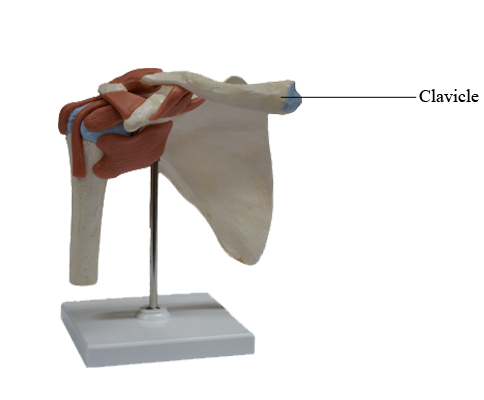Main Model

Anterior : Clavicle

Clavicle
The clavicle (collar bone) connects the upper limb to the trunk. The shaft of the clavicle has a double curve in a horizontal plane. Its medial half is convex anteriorly, and its sternal end is enlarged and triangular where it articulates with the manubrium of the sternum at the sternoclavicular joint (SC joint). Its lateral half is concave anteriorly, and its acromial end is flat where it articulates with the acromion of the scapula at the acromioclavicular joint (AC joint). The medial two thirds of the shaft of the clavicle are convex anteriorly, whereas the lateral third is flattened and concave anteriorly. These curvatures increase the resilience of the clavicle, and give it the appearance of an elongated capital S.
The clavicle:
• Serves as a moveable, crane-like strut (rigid support) from which the scapula and free limb are suspended, keeping them away from the trunk so that the limb has maximum freedom of motion. The strut is movable and allows the scapula to move on the thoracic wall at the "scapulothoracic joint," increasing the range of motion of the limb. Fixing the strut in position, especially after its elevation, enables elevation of the ribs for deep inspiration.
• Forms one of the bony boundaries of the cervico-axillary canal (passageway between the neck and arm), affording protection to the neurovascular bundle supplying the upper limb.
• Transmits shocks (traumatic impacts) from the upper limb to the axial skeleton.
• Serves as a moveable, crane-like strut (rigid support) from which the scapula and free limb are suspended, keeping them away from the trunk so that the limb has maximum freedom of motion. The strut is movable and allows the scapula to move on the thoracic wall at the "scapulothoracic joint," increasing the range of motion of the limb. Fixing the strut in position, especially after its elevation, enables elevation of the ribs for deep inspiration.
• Forms one of the bony boundaries of the cervico-axillary canal (passageway between the neck and arm), affording protection to the neurovascular bundle supplying the upper limb.
• Transmits shocks (traumatic impacts) from the upper limb to the axial skeleton.
Although designated as a long bone, the clavicle has no medullary (marrow) cavity. It consists of spongy (trabecular) bone with a shell of compact bone.
The superior surface of the clavicle, lying just deep to the skin and platysma (Greek flat plate) muscle in the subcutaneous tissue, is smooth.
The inferior surface of the clavicle is rough because strong ligaments bind it to the 1st rib near its sternal end and suspend the scapula from its acromial end. The conoid tubercle, near the acromial end of the clavicle, gives attachment to the conoid ligament, the medial part of the coracoclavicular ligament by which the remainder of the upper limb is passively suspended from the clavicle. Also, near the acromial end of the clavicle is the trapezoid line, to which the trapezoid ligament attaches; it is the lateral part of the coracoclavicular ligament.
The subclavian groove (groove for the subclavius) in the medial third of the shaft of the clavicle is the site of attachment of the subclavius muscle. More medially is the impression for the costoclavicular ligament, a rough, often depressed, oval area that gives attachment to the ligament binding the 1st rib (Latin costa) to the clavicle, limiting elevation of the shoulder.